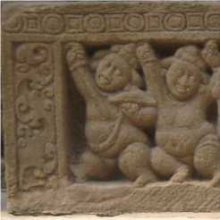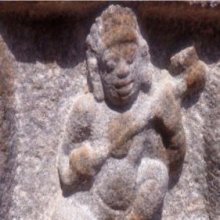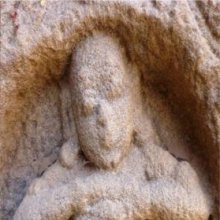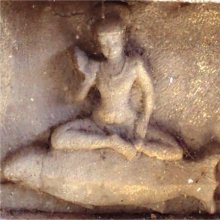Adhishthana, Adhiṣṭhāna: 28 definitions
Introduction:
Adhishthana means something in Buddhism, Pali, Hinduism, Sanskrit, the history of ancient India, Marathi, Hindi. If you want to know the exact meaning, history, etymology or English translation of this term then check out the descriptions on this page. Add your comment or reference to a book if you want to contribute to this summary article.
The Sanskrit term Adhiṣṭhāna can be transliterated into English as Adhisthana or Adhishthana, using the IAST transliteration scheme (?).
Alternative spellings of this word include Adhishthan.
Images (photo gallery)
(+3 more images available)
In Hinduism
Shilpashastra (iconography)
Source: Wisdom Library: Śilpa-śāstra1) Adhiṣṭhāna (अधिष्ठान) refers to a “plinth”, “pedestal” or “molded base”.
2) Adhiṣṭhāna can also refer to an “object on which something stands”. According to the Mayamata, an adhiṣṭhāna may be optionally provided with an upapīṭha (sub-structure), but according to the Pādmasaṃhitā this is mandatory.
According to the Mayamata, Adhiṣṭhāna has the following synonyms: Masūraka, Vāstvādhāra, Kuttima, Tala; while the Kāmikāgama extends this lists with: Dharātala, Ādhāra, Dharaṇi, Bhuvana, Pṛthvī, Bhūmi and Ādyaṅga.
3) Adhiṣṭhāna (‘plinth’) represents a part of the trivarga structure, where it is also known as upāna.

Shilpashastra (शिल्पशास्त्र, śilpaśāstra) represents the ancient Indian science (shastra) of creative arts (shilpa) such as sculpture, iconography and painting. Closely related to Vastushastra (architecture), they often share the same literature.
Vastushastra (architecture)
Source: Wisdom Library: Vāstu-śāstraAdhiṣṭhāna (अधिष्ठान) refers to the “plinth” or “base” of a temple (prāsāda or vimāna). It is considered the first part in the ṣaḍvarga structure.
Source: Shodhganga: Development of temple architecture in Southern KarnatakaThe term adhiṣṭhāna is derived from the Sanskrit root ‘adhiṣṭha’ meaning ‘to stand upon’. As such, etymologically, adhiṣṭhāna denotes an object on which something stands.
The main mouldings of the adhiṣṭhāna are:
- upāna,
- jagati,
- kumuda,
- gala,
- kapota or paṭṭikā or both,
- prati.
Kāśyapaśilpa mentions only five major mouldings for the adhiṣṭāna. They are the upāna, jagati, kumuda, kampa (paṭṭi) and paṭṭikā. This is called as the pañcavarga. It is also mentioned that, those adhiṣṭānas which have the pañcavarga are the best adhiṣṭānas.
Source: OpenEdition books: Architectural terms contained in Ajitāgama and RauravāgamaAdhiṣṭhāna (अधिष्ठान) refers to “basement, level of - §§ 2.24, 25; 3.1, 14; 5.11; ...”.—(For paragraphs cf. Les enseignements architecturaux de l'Ajitāgama et du Rauravāgama by Bruno Dagens)

Vastushastra (वास्तुशास्त्र, vāstuśāstra) refers to the ancient Indian science (shastra) of architecture (vastu), dealing with topics such architecture, sculpture, town-building, fort building and various other constructions. Vastu also deals with the philosophy of the architectural relation with the cosmic universe.
Ayurveda (science of life)
Source: gurumukhi.ru: Ayurveda glossary of terms1) Adhiṣṭhāna (अधिष्ठान):—[adhiṣṭhānam] Seat (of poison)
2) [adhiṣṭhānam] Substratum or place of action

Āyurveda (आयुर्वेद, ayurveda) is a branch of Indian science dealing with medicine, herbalism, taxology, anatomy, surgery, alchemy and related topics. Traditional practice of Āyurveda in ancient India dates back to at least the first millenium BC. Literature is commonly written in Sanskrit using various poetic metres.
Shaktism (Shakta philosophy)
Source: Google Books: ManthanabhairavatantramAdhiṣṭhāna (अधिष्ठान) refers to the “support” (of the forces), according to Tantric texts such as the Kubjikāmata-tantra, the earliest popular and most authoritative Tantra of the Kubjikā cult.—Accordingly, as Bhairava says to the Goddes: “Thus, O goddess, (this centre is called) svādhiṣṭhāna because it is by this that the wise bearer of the Wheel (i.e. Śiva) was previously supported by himself (svādhiṣṭhita) in the Liṅga. This is the location of both Māyā and the Śāmbhava plane. It is the teaching concerning the support (adhiṣṭhāna) of the forces. It contains the individualized form of the Person (puruṣāṇu) and so is rightly called ‘one’s own support’ (svādhiṣṭhāna) [...]”.

Shakta (शाक्त, śākta) or Shaktism (śāktism) represents a tradition of Hinduism where the Goddess (Devi) is revered and worshipped. Shakta literature includes a range of scriptures, including various Agamas and Tantras, although its roots may be traced back to the Vedas.
Pancaratra (worship of Nārāyaṇa)
Source: University of Vienna: Sudarśana's Worship at the Royal Court According to the AhirbudhnyasaṃhitāAdhiṣṭhāna (अधिष्ठान) refers to the “base” (of the creative energy), according to the Ahirbudhnyasaṃhitā, belonging to the Pāñcarātra tradition which deals with theology, rituals, iconography, narrative mythology and others.—Accordingly, “[...] A Brāhmaṇa who is not supported may not act with it (i.e. the kriyāśakti) in this world. But he may perform with it for the good of the world, having first relied upon the King. For the King is the Supreme Being, he embodies all Gods and is all-pervading. He is the base (adhiṣṭhāna) of the Creative Energy (kriyāśakti) belonging to Viṣṇu, and embodies the Lord. [...]”.

Pancaratra (पाञ्चरात्र, pāñcarātra) represents a tradition of Hinduism where Narayana is revered and worshipped. Closeley related to Vaishnavism, the Pancaratra literature includes various Agamas and tantras incorporating many Vaishnava philosophies.
Purana and Itihasa (epic history)
Source: archive.org: Shiva Purana - English TranslationAdhiṣṭhāna (अधिष्ठान) refers to the “support (of a chariot)”, according to the Śivapurāṇa 2.5.8 (“The detailed description of the chariot etc.”).—Accordingly, as Sanatkumāra narrated to Vyāsa: “The divine chariot of lord Śiva consisting of all the worlds was built by Viśvakarman with devoted effort. [...] The six seasons constituted the rims of the wheels of the chariot, O great Brahmin. The Puṣkara of the chariot was the sky. The inner side of the chariot was Mandara. The rising and the setting mountains constituted the poleshafts. Mahāmeru was the support (adhiṣṭhāna) and the Keśara mountains the sharp sides. [...]”.

The Purana (पुराण, purāṇas) refers to Sanskrit literature preserving ancient India’s vast cultural history, including historical legends, religious ceremonies, various arts and sciences. The eighteen mahapuranas total over 400,000 shlokas (metrical couplets) and date to at least several centuries BCE.
Shaivism (Shaiva philosophy)
Source: eScholarship: The descent of scripture: a history of the KamikagamaAdhiṣṭhāna (अधिष्ठान) refers to the “(architectural features of the) foundation”, according to the Kāmikāgama: an ancient Śaiva Āgama scripture in 12,000 Sanskrit verses dating to at least the 5th century and represented as an encyclopedic account of ritual instructions (kriyāpāda).—In modern print editions, the Kāmika-āgama is structured in two major parts. The Pūrvabhāga consists of 75 chapters (paṭalas) [...] Chapters 49 to 61 focus on temple architecture and construction. [...] Chapter 51 presents a treatment of the ritual of laying the first brick. Chapter 52 focuses on the construction and architectural features of the foundation and ground floor (upapīṭha-adhiṣṭhāna).

Shaiva (शैव, śaiva) or Shaivism (śaivism) represents a tradition of Hinduism worshiping Shiva as the supreme being. Closely related to Shaktism, Shaiva literature includes a range of scriptures, including Tantras, while the root of this tradition may be traced back to the ancient Vedas.
In Buddhism
Tibetan Buddhism (Vajrayana or tantric Buddhism)
Source: WikiPedia: Tibetan BuddhismThe Sanskrit term adhiṣṭhāna is the name for initiations or blessings in Vajrayāna Buddhism. In Tibetan Buddhism adhiṣṭhāna blessings are an important part of the pointing-out instruction received from the Guru and lineage. Receiving these blessings is dependent on the student having proper motivation, aspiration and intentionality (bodhicitta) and sufficient “devotion” (Sanskrit: bhakti).
The term adhiṣṭhāna is also used to describe the transformative power of the Buddha. According to D. T. Suzuki: “The Buddha is creative life itself, he creates himself in innumerable forms with all the means native to him. This is called his adhiṣṭhāna, as it were, emanating from his personality.”

Tibetan Buddhism includes schools such as Nyingma, Kadampa, Kagyu and Gelug. Their primary canon of literature is divided in two broad categories: The Kangyur, which consists of Buddha’s words, and the Tengyur, which includes commentaries from various sources. Esotericism and tantra techniques (vajrayāna) are collected indepently.
Mahayana (major branch of Buddhism)
Source: academia.edu: A Study and Translation of the GaganagañjaparipṛcchāAdhiṣṭhāna (अधिष्ठान) refers to “presence”, according to the Gaganagañjaparipṛcchā: the eighth chapter of the Mahāsaṃnipāta (a collection of Mahāyāna Buddhist Sūtras).—Accordingly as The Lord said: “O Śāriputra, in the buddha-field of the Tathāgata Ekaratnavyūha, there is a Bodhisattva, the great being Gaganagañja who is resplendent by the splendor of merit (puṇya-tejas), [...] has depended upon the knowledge which is based on itself as adorned with the great praise by all Buddhas, and has entered into all dharmas and discipline of the Buddha as adorned with the accumulation of all qualities [of a Buddha]. Śāriputra, that which is the grand display shining forth like this is the presence (adhiṣṭhāna) of the Bodhisattva Gaganagañja”.
Source: De Gruyter: A Buddhist Ritual Manual on AgricultureAdhiṣṭhāna (अधिष्ठान) refers to “empowerment (of miracles)”, according to the Vajratuṇḍasamayakalparāja, an ancient Buddhist ritual manual on agriculture from the 5th-century (or earlier), containing various instructions for the Sangha to provide agriculture-related services to laypeople including rain-making, weather control and crop protection.—Accordingly, [after hostile Nāgas released winds, thunderbolts, etc.] “[...] Beings experience great and severe suffering. Listen, O Nāgas, there is the evident empowerment of the Tathāgata’s miracles (vikurvita-adhiṣṭhāna). Behold the deep knowledge of the Buddha, the power of the Tathāgata, the empowerment of special merit”.

Mahayana (महायान, mahāyāna) is a major branch of Buddhism focusing on the path of a Bodhisattva (spiritual aspirants/ enlightened beings). Extant literature is vast and primarely composed in the Sanskrit language. There are many sūtras of which some of the earliest are the various Prajñāpāramitā sūtras.
India history and geography
Source: Cologne Digital Sanskrit Dictionaries: Indian Epigraphical GlossaryAdhisthāna.—(CII 1), cf. dharm-ādhisthāna, dharm- ādhiṣṭhāna, ‘the establishment of morality’. Note: adhisthāna is defined in the “Indian epigraphical glossary” as it can be found on ancient inscriptions commonly written in Sanskrit, Prakrit or Dravidian languages.
See also (synonyms): Adhiṣṭhāna.
--- OR ---
Adhiṣṭhāna.—(IE 8-3; EI 24, 28, 31; LL), the capital or headquarters of an administrative unit; a city or town; the chief city. See abhisthāna. (EI 9), probably, residence. (EI 8), same as sthāna. (EI 24), cf. adhiṣṭhānam, ‘under the supervision of’. (SITI), the base of the vimāna in a temple; a seat. Note: adhiṣṭhāna is defined in the “Indian epigraphical glossary” as it can be found on ancient inscriptions commonly written in Sanskrit, Prakrit or Dravidian languages.

The history of India traces the identification of countries, villages, towns and other regions of India, as well as mythology, zoology, royal dynasties, rulers, tribes, local festivities and traditions and regional languages. Ancient India enjoyed religious freedom and encourages the path of Dharma, a concept common to Buddhism, Hinduism, and Jainism.
Languages of India and abroad
Marathi-English dictionary
Source: DDSA: The Molesworth Marathi and English Dictionaryadhiṣṭhāna (अधिष्ठान).—n (S) Abiding, residing, or staying in: inhering, lying, or being in. 2 The place, seat, subject &c. of indwelling. 3 fig. Sitting in restraint at a person's door;--in order to enforce compliance with some demand. 4 Ostentatious display (of piety or sanctity, of learning, opulence &c.)
Source: DDSA: The Aryabhusan school dictionary, Marathi-Englishadhiṣṭhāna (अधिष्ठान).—n Abiding, inhering.
Marathi is an Indo-European language having over 70 million native speakers people in (predominantly) Maharashtra India. Marathi, like many other Indo-Aryan languages, evolved from early forms of Prakrit, which itself is a subset of Sanskrit, one of the most ancient languages of the world.
Sanskrit dictionary
Source: DDSA: The practical Sanskrit-English dictionaryAdhiṣṭhāna (अधिष्ठान).—[adhi-sthā-lyuṭ]
1) Standing or being near, being at hand, approach (sannidhi); अत्राधिष्ठानं कुरु (atrādhiṣṭhānaṃ kuru) take a seat here.
2) Resting upon, occupying, inhabiting, dwelling in, locating oneself in; प्राणाधिष्ठानं देहस्य (prāṇādhiṣṭhānaṃ dehasya) &c.
3) A position, site, basis, seat; त्र्यधिष्ठानस्य देहिनः (tryadhiṣṭhānasya dehinaḥ) Manusmṛti 12.4; इन्द्रियाणि मनो बुद्धिरस्याधिष्ठानमुच्यते (indriyāṇi mano buddhirasyādhiṣṭhānamucyate) Bhagavadgītā (Bombay) 3.4, 18.14 the seat (of that desire.)
4) Residence, abode; नगरं राजाधिष्ठानम् (nagaraṃ rājādhiṣṭhānam) Pañcatantra (Bombay) 1.; so धर्म° (dharma°); a place, locality, town; सर्वाविनयाधिष्ठानतां गच्छन्ति (sarvāvinayādhiṣṭhānatāṃ gacchanti) K.16; कस्मिंश्चिदधिष्ठाने (kasmiṃścidadhiṣṭhāne) in a certain place.
5) Authority, power, power of control, presiding over; अनधिष्ठानम् (anadhiṣṭhānam) H.3.83. lose of position, dimissal from a post (of authority); समर्थस्त्वमिमं जेतुमधिष्ठानपराक्रमैः (samarthastvamimaṃ jetumadhiṣṭhānaparākramaiḥ) Rām.; ययेह अश्वैर्युक्तो रथः सार- थिनाऽधिष्ठितः प्रवर्तते तथा आत्माधिष्ठानाच्छरीरम् (yayeha aśvairyukto rathaḥ sāra- thinā'dhiṣṭhitaḥ pravartate tathā ātmādhiṣṭhānāccharīram) Gaudapāda; महाश्वेताकृताच्च सत्याधिष्ठानात् (mahāśvetākṛtācca satyādhiṣṭhānāt) K.346 appeal or reference to truth.
6) Government, dominion.
7) A wheel (of a car &c.) अधिष्ठानं मनश्चासीत्परिरथ्या सरस्वती (adhiṣṭhānaṃ manaścāsītparirathyā sarasvatī) Mahābhārata (Bombay) 8.34.34; 5.178.74.
8) A precedent, prescribed rule.
9) A benediction. cf. अधिष्ठानं चक्रपुरप्रभावाध्यासनेष्वपि (adhiṣṭhānaṃ cakrapuraprabhāvādhyāsaneṣvapi) | Nm.
1) Destruction (?); अमित्राणामधिष्ठानाद्वधाद् दुर्योधनस्य च । भीम दिष्ट्या पृथिव्यां ते प्रथितं सुमहद्यशः (amitrāṇāmadhiṣṭhānādvadhād duryodhanasya ca | bhīma diṣṭyā pṛthivyāṃ te prathitaṃ sumahadyaśaḥ) || Mahābhārata (Bombay) 9.61.14.
11) Couch, seat, bed; साधिष्ठानानि सर्वशः (sādhiṣṭhānāni sarvaśaḥ) Rām.6.75.19.
12) A butt (for an allurement.) तस्माद् ब्राह्ममधिष्ठानं कृत्वा कार्ये चतुर्विधे (tasmād brāhmamadhiṣṭhānaṃ kṛtvā kārye caturvidhe) | Kau. A.1.1.
Derivable forms: adhiṣṭhānam (अधिष्ठानम्).
Source: Cologne Digital Sanskrit Dictionaries: Edgerton Buddhist Hybrid Sanskrit DictionaryAdhiṣṭhāna (अधिष्ठान).—(regularly) nt. (= Pali adhiṭṭhāna; see 6 below for forms of other genders; from adhitiṣṭhati, q.v.), (1) basis, as in Sanskrit ([Boehtlingk and Roth] s.v. 1); special usage, Saddharmapuṇḍarīka 405.8—9 (a Buddha of old preached the Saddharmapuṇḍarīka at length) Sarvasattvapriyadarśanaṃ bodhisattvaṃ…adhiṣṭhānaṃ kṛtvā, making (his disciple) the Bodhisattva S. the basis, i.e. with special regard to him, or for his special benefit; (2) (mental) firm basis = determination, resolve, resolution, vow, = Pali (cetaso) adhiṭṭhāna (see Critical Pali Dictionary); rare in [Buddhist Hybrid Sanskrit]: (a Bodhisattva is about to burn his body to honor the Saddharmapuṇḍarīka and the Buddha who revealed it to him; having purified, adorned, and scented his body) svakam adhiṣṭhānam akarot Saddharmapuṇḍarīka 407.6, he made his resolution, firm mental determination; followed by svakam adhiṣṭhānaṃ kṛtvā svaṃ kāyaṃ prajvālayām āsa; buddhān bhagavataḥ sākṣiṇaḥ kṛtvā teṣāṃ purataḥ satyādhiṣṭhānaṃ (q.v.) karomi: yena satyena etc., Saddharmapuṇḍarīka 413.7—8,…I make a truthful resolve… and he proceeds with an ‘act of truth’, see satyavacana; (?) Lalitavistara 423.5-6 akṣaṇasattvavinayādhiṣṭhānāpratyudāvar- tyacakraṃ (said of the dharmacakra; text °dhiṣṭhāna- praty°, but see s.v. apratyudāvartya), wheel that cannot be turned back because of (the Buddha's) fixed determination to discipline creatures that are subject to bad births (? or possibly because of the Buddha's supernatural power to discipline etc.; otherwise, implausibly, Foucaux); here perhaps also the ‘four adhisthāna’ (firm resolves?) of Mahāvyutpatti 1580—84 (satya-, tyāga-, upasama-, prajñā-) = Pali four [Page016-a+ 71] adhiṭṭhāna, Dīghanikāya (Pali) iii.229.18 (paññā-, sacca-, cāga-, upasama-); (3) in Sanskrit ([Boehtlingk and Roth] s.v. 2) mastery, power; in [Buddhist Hybrid Sanskrit] control, e.g. of a monk's own robes (compare adhitiṣṭhati 1), Mūla-Sarvāstivāda-Vinaya ii.91.12 tricīvarādhiṣṭhānena; oftener supernatural, magic power: puṇyavipākādhiṣṭhānādhiṣṭhitās Lalitavistara 48.21 (Apsa- rases) empowered (controlled) by the power of the ripening of merit (which enables them to disappear from their heavenly home and appear in Kapilavastu); -devatādhiṣṭhānāt Lalitavistara 381.12, by the magic power of the…deity (the merchants' wagons were stopped and could not be moved); usually a Buddha's or Bodhisattva's; it may be his supernatural control over his own destiny, Saddharmapuṇḍarīka 64.13, where bodhisattvā- dhiṣṭhānena goes closely with tat paurvakaṃ caryāpraṇi- dhānam, see s.v. saṃmantrita; but it is usually control over another person, a Bodhisattva or disciple: Maitreyasya bodhisattvasyādhiṣṭhānabalena sarveṣu teṣu kūṭāgāreṣv abhyantarapraviṣṭam ātmānaṃ saṃjānīte sma, Gaṇḍavyūha 512.13- 14, by the force of the supernatural power of Maitreya (Sudhana) fancied that he had entered into each one of those palaces; buddhānāṃ…adhiṣṭhānena Lalitavistara 163.9—10 (text adhisthān°; when the women were making music for the Bodhisattva) by the supernatural power of the Buddhas verses of exhortation to him came forth (in 163.14 āveśa, q.v., or v.l. ādeśa, replaces adhi°); similarly 182.3; adhi- ṣṭhānena buddhānām anubhāvād (another near-synonym) vikurvitaiḥ Samādhirājasūtra 22.19 (the body of the Buddha can be seen); other like cases Laṅkāvatāra-sūtra 2.10; Lalitavistara 31.3, 6; 237.18; 368.12; in 415.16, the dharmacakra is sarvabuddhādhiṣ- ṭhānāvilopitam, unbroken thru the supernatural power (influence) of all the Buddhas; for Laṅkāvatāra-sūtra 100.6 and (Ārya-)Mañjuśrīmūlakalpa 56.24 see s.v. adhitiṣṭhati (2); etaṃ…samādhiṃ samā- pannasyādhiṣṭhānam: lokadhātuvijñaptiṣu adhiṣṭhānam, etc., long series of locs. each with adhi° repeated, stating the spheres of the mastery obtained, Gaṇḍavyūha 98.15 ff.; mamā- dhiṣṭhānabalādhānam Saddharmapuṇḍarīka 316.1, my assumption of the force of supernatural (magic) power (here causes people to believe that the earthly life of Śākyamuni, which was unreal, is real); but the corresponding verse, 323.13, has adhiṣṭha- hāmi in the sense of I make appear by magic (see adhitiṣ- ṭhati 3), and possibly adhiṣṭhāna may be concrete here (and in sadādhiṣṭhānaṃ mama etad īdṛśaṃ Saddharmapuṇḍarīka 324.11, resuming the same subject), exhibition of supernatural (magic) power = magical appearance or transformation; this latter is certainly the meaning in Lalitavistara 379.3, see adhitiṣṭhati (3), and perhaps in Prabhūtaratnasya tathāgatasya…etad adhiṣṭhānam abhūt Saddharmapuṇḍarīka 241.8, this was the adhiṣṭhāna of the Tathāgata P. (there follows a quotation of his words: Let this stūpa of my remains appear whenever the Saddharmapuṇḍarīka is preached). Does this adhiṣṭhāna mean this exhibition of supernatural power, viz, the making of the stūpa to appear? Or is it this fixed determination, resolution (2, above)? Near synonyms are āveśa, (Sanskrit) anubhāva, adhimukti; compare also Laṅkāvatāra-sūtra 292.13 and 15, where one of the sources of abhijñā is ‘from adhiṣṭhāna’ (adhiṣṭhānān, so read in 13 for text °nāṃ, abl., before n-), which means from the controlling power of the Buddhas and is paraphrased in 15 by buddhaprasādataḥ, from the grace of the Buddhas. Suzuki, Transl. of Laṅkāvatāra-sūtra passim, renders sustaining power; I think rather controlling power. Even Bodhisattvas are at times dependent on Buddhas and need their control; (4) in architecture, Sanskrit (see Acharya, Dict. Hindu Arch. s.v.), basement, foundation of building or base of a pillar. Here in Mahāvyutpatti 5591 = Tibetan lan kan gyi rten ma, prop (i.e. base) of a railing; so Chin. Whatever it means here is certainly meant also in Divyāvadāna 221.9, 10 adhiṣṭhānam, and Mahāvastu i.195.1 ff.; iii.227.8 ff., adhiṣṭhānakam, where the context is the same as in Mahāvyutpatti 5591; see sūcī, sūcikā; (5) see pādādhiṣṭhāna; (6) m., name of a (mythical) samādhi: Gaṇḍavyūha 451.26. In this curious passage, 451.25—452.6, the word adhiṣṭhāna is further used predicatively in a series of equational sentences, varying in gender like an adjective [Page016-b+ 71] with different subjects. Bhadrottamā says to Sudhana: ahaṃ kulaputrā 'nālayamaṇḍalaṃ nāma dharmaparyāyaṃ jānāmi deśayāmy, adhiṣṭhānaś ca me samādhiḥ pratilab- dho; na tatra samādhau kasyacid dharmasyā 'dhiṣṭhānam; adhiṣṭhānaṃ tatra sarvajñatācakṣuḥ pravartate, 'dhiṣṭhā- naṃ sarvajñatāśrotram, adhiṣṭhānaṃ sarvajñatāghrāṇam, adhiṣṭhānā sarvajñatājihvā, 'dhiṣṭhānaḥ sarvajñatākāyo, 'dhiṣṭhānaṃ tatra sarvajñatāmanaḥ pravartate, 'dhiṣṭhānā sarvajñatormir, adhiṣṭhānā sarvajñatāvidyud, adhiṣṭhānāḥ sarvajñatāvegāḥ pravartante jagadrocanāmaṇḍalāḥ; etam ahaṃ kulaputrā 'nālayamaṇḍalaṃ dharmaparyāyaṃ jā- nāmi.(Punctuation introduced by me.) There is no further light from the context. I am not sure what meaning the author attributed to the word adhiṣṭhāna: presumably something like either basis or controlling power.
--- OR ---
Adhisthāna (अधिस्थान).—[ is read for adhiṣṭhāna, q.v., in Lalitavistara 163.10 (according to Lefm. with all mss.) and 182.3 (here v.l. -ṣṭh-).]
Source: Cologne Digital Sanskrit Dictionaries: Shabda-Sagara Sanskrit-English DictionaryAdhiṣṭhāna (अधिष्ठान).—n.
(-naṃ) 1. Abiding, resting; 2. Site, situation. 3. Prescribed rule, fixed practice. 5. A town. 6. A wheel. 7. Dignity. E. adhi, sthā to stand, and lyuṭ aff.
Source: Cologne Digital Sanskrit Dictionaries: Benfey Sanskrit-English DictionaryAdhiṣṭhāna (अधिष्ठान).—i. e. adhi -sthā + ana, n. 1. A resting-place. 2. A seat, [Mānavadharmaśāstra] 12, 4. 3. An abode. 4. A place, [Pañcatantra] 10, 3. 5. A town, a capital, [Rājataraṅgiṇī] 5, 266. 6. Dignity, [Nala] 26, 28. 7. Power, [Rāmāyaṇa] 4, 14, 30.
Source: Cologne Digital Sanskrit Dictionaries: Cappeller Sanskrit-English DictionaryAdhiṣṭhāna (अधिष्ठान).—[neuter] standing or dwelling-place; residence, capital; high position, power, dignity.
Source: Cologne Digital Sanskrit Dictionaries: Monier-Williams Sanskrit-English Dictionary1) Adhiṣṭhāna (अधिष्ठान):—[=adhi-ṣṭhāna] [from adhi-ṣṭhā] n. standing by, being at hand, approach
2) [v.s. ...] standing or resting upon
3) [v.s. ...] a basis, base
4) [v.s. ...] the standing-place of the warrior upon the car, [Sāma-vidhāna-brāhmaṇa]
5) [v.s. ...] a position, site, residence, abode, seat
6) [v.s. ...] a settlement, town, standing over
7) [v.s. ...] government, authority, power
8) [v.s. ...] a precedent, rule
9) [v.s. ...] a benediction, [Buddhist literature]
10) [from adhi-ṣṭhāna > adhi-ṣṭhā] (with Buddhists) steadfast resolution (one of the 6 or 10 Pāramitās, q.v.), [Monier-Williams’ Buddhism 128]
11) [v.s. ...] a king’s court, [Divyāvadāna]
Source: Cologne Digital Sanskrit Dictionaries: Goldstücker Sanskrit-English DictionaryAdhiṣṭhāna (अधिष्ठान):—[tatpurusha compound] n.
(-nam) 1) Abiding, resting upon.
2) Site, situation.
3) A town.
4) (In architecture.) Base, basement.
5) Power, dignity, superintendence.
6) Prescribed rule, fixed practice.
7) A wheel.
8) Approaching.
9) (In Buddhistic literature.) Benediction. E. sthā with adhi, kṛt aff. lyuṭ.
Source: Cologne Digital Sanskrit Dictionaries: Yates Sanskrit-English DictionaryAdhiṣṭhāna (अधिष्ठान):—[adhi-ṣṭhāna] (naṃ) 1. n. Abiding; scite; fixed rule; a town; a wheel.
Source: DDSA: Paia-sadda-mahannavo; a comprehensive Prakrit Hindi dictionary (S)Adhiṣṭhāna (अधिष्ठान) in the Sanskrit language is related to the Prakrit words: Ahiṭṭhāṇa, Ahiṭhāṇa.
[Sanskrit to German]
Sanskrit, also spelled संस्कृतम् (saṃskṛtam), is an ancient language of India commonly seen as the grandmother of the Indo-European language family (even English!). Closely allied with Prakrit and Pali, Sanskrit is more exhaustive in both grammar and terms and has the most extensive collection of literature in the world, greatly surpassing its sister-languages Greek and Latin.
Hindi dictionary
Source: DDSA: A practical Hindi-English dictionaryAdhiṣṭhāna (अधिष्ठान) [Also spelled adhishthan]:—(nm) an establishment; abode, dwelling; hence ~[ṣṭhita] (a).
...
Kannada-English dictionary
Source: Alar: Kannada-English corpusAdhiṣṭhāna (ಅಧಿಷ್ಠಾನ):—
1) [noun] act of establishing, planting, positioning an object in a place.
2) [noun] the fact of being established, planted or fixed at a place.
3) [noun] a place where one lives or stays; home; residence.
4) [noun] the base on which something rests; esp., the supporting part of a wall, house, etc., usually of masonry, concrete, etc., and at least partially underground; basement; foundation.
5) [noun] a centre of population, business and is larger than a town or village; a city.
6) [noun] the act or process or power of governing; governance; authority.
7) [noun] a solid disk or a circular frame connected by spokes to a central hub, capable of turning on a central axis and used as to move vehicles; a wheel.
8) [noun] a rule or an authoritative regulation for action, conduct, method, procedure, arrangement, etc or an established practice that serves as a guide to usage.
9) [noun] good wishes or blessing.
Kannada is a Dravidian language (as opposed to the Indo-European language family) mainly spoken in the southwestern region of India.
See also (Relevant definitions)
Partial matches: Sthana, Adhi.
Starts with: Adhishthanadeha, Adhishthanadhikarana, Adhishthanadhishthita, Adhishthanagattu, Adhishthanagol, Adhishthanaka, Adhishthanamgattu, Adhishthanasharira, Adhishthanasutra, Adhishthanavant.
Ends with (+8): Agnyadhishthana, Anadhishthana, Buddhadhishthana, Dharmadhishthana, Gunadhishthana, Indriyadhishthana, Mantrapatradhishthana, Niradhishthana, Padadhishthana, Panishalakadhishthana, Pratyadhishthana, Pushpadhishthana, Rajadhishthana, Sadhishthana, Samadhishthana, Satyadhishthana, Shabdadhishthana, Shankhadhishthana, Sukhadhishthana, Svadhishthana.
Full-text (+132): Adhishthanasharira, Shabdadhishthana, Tryadhishthana, Svadhishthana, Pancavarga, Pattika, Adhishthanadeha, Adhishthanadhikarana, Ahitthana, Kukshibandha, Niradhishthana, Kumbhabandha, Mancabandha, Vajrabandha, Shiluksha, Abhisthana, Atishtanam, Pratikrama, Kapota, Pushpapushkala.
Relevant text
Search found 70 books and stories containing Adhishthana, Adhiṣṭhāna, Adhisthana, Adhisthāna, Adhi-shthana, Adhi-ṣṭhāna, Adhi-sthana, Adhishtana, Adhiṣṭāna, Adhistana; (plurals include: Adhishthanas, Adhiṣṭhānas, Adhisthanas, Adhisthānas, shthanas, ṣṭhānas, sthanas, Adhishtanas, Adhiṣṭānas, Adhistanas). You can also click to the full overview containing English textual excerpts. Below are direct links for the most relevant articles:
Early Chola Temples (by S. R. Balasubrahmanyam)
Temples in Paramesvaramangalam < [Chapter VIII - Temples of Uttama Chola’s Time]
Introduction < [Chapter XIII - Prasada: Component Parts]
Temples in Tiruvaduturai (3rd to 25th year) < [Chapter X - Historical Survey]
Temples of Munnur (Historical Study) (by R. Muthuraman)
Adavalleswarar or Adavalleeswarar Temple (Architecture) < [Chapter 4]
Arulala Perumal Temple < [Chapter 4]
Nataraja sabha < [Chapter 4]
Shrimad Bhagavad-gita (by Narayana Gosvami)
Verse 18.14 < [Chapter 18 - Mokṣa-yoga (the Yoga of Liberation)]
Verse 3.40 < [Chapter 3 - Karma-yoga (Yoga through the Path of Action)]
Taittiriya Upanishad Bhashya Vartika (by R. Balasubramanian)
Verse 2.354 < [Book 2 - Brahmavallī]
Verse 2.412 < [Book 2 - Brahmavallī]
Verse 2.177 < [Book 2 - Brahmavallī]
Kashyapa Shilpa-shastra (study) (by K. Vidyuta)
4. Prākāra components (2): Pāda-māna < [Chapter 3 - Prākāra Lakṣaṇa]
6. Components in the Storeys of the Gopuras < [Chapter 5 - Gopura Lakṣaṇa]
4 (b). Technical terms for the component parts of the temple < [Chapter 2 - Author and his Works]
A History of Indian Philosophy Volume 1 (by Surendranath Dasgupta)
Part 8 - The nature of the world-appearance, phenomena < [Chapter X - The Śaṅkara School Of Vedānta]





